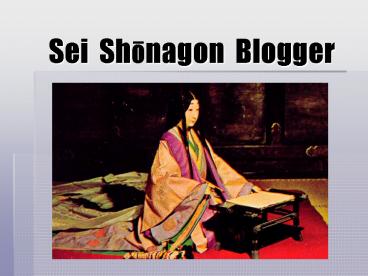Sei Shonagon Blogger - PowerPoint PPT Presentation
Title:
Sei Shonagon Blogger
Description:
Title: Slide 1 Author: Tim Lenoir Last modified by: Tim Lenoir Created Date: 10/20/2003 4:25:35 PM Document presentation format: On-screen Show Company – PowerPoint PPT presentation
Number of Views:89
Avg rating:3.0/5.0
Title: Sei Shonagon Blogger
1
Sei Shonagon Blogger
2
What is an Author?
- Locating the author as an individual
- Author as outside and preceding the text
- The source of meaning and intention
- The text as the product of genius expressing
itself in writing - This parallels our discussion of Platonism and
Western metaphysics - The metaphysics of presence
- Truth/Knowledge in Plato
- The Book/Author
- Christian parallelsGod and the Word
3
What is an Author?
The author constitutes a principle of unity in
writing where any unevenness of production is
ascribed to changes caused by evolution,
maturation, or outside influence. In addition,
the author serves to neutralize the
contradictions that are found in ... texts.
Governing this function is the belief that there
must be at a particular level of an authors
thought, of his conscious or unconscious desire
a point where contradictions are resolved, where
the incompatible elements can be shown to relate
to one another...
Michel Foucault
4
The Author-Function
- Archaeologists of discourse
- Examine clusters of statements, layers of
discourse - Examine the conditions for existence of
configurations of statements (rather than
pre-existing meanings and intentions) - Strip the subject (and its substitutes) of its
creative role and analyze as a complex and
variable function of discourse - Writing reverses its role from being derivative,
imitative to being primary and originary - Materialities of the Text
- Agreements about appearance, format, fonts,
paper, etc., in the production and distribution
of books - Points to the existence of a system for
production and circulation of the text - Modes of remunerationreviewappreciation
5
The Author-Function
- The author-function is characteristic of the mode
of existence, circulation, and function of
certain discourses in society - Certain discourses are endowed with an author
function, others are not - Not every discourse can be accorded the status of
being the product of an author - Author is a position that defines a subject in
a discourse network rather than a quality
inherent in an individual, for instance,
Shakespeare
6
The Author-Function
- From these (archaeological) premises it follows
that - The form, complexity, even the existence of the
author-function is highly mutable - We can imagine a culture where discourse could
circulate without an author - Disourses of whatever value or status could
unfold in anonymity
7
The Author-Function
- No longer the questions
- Who is the real author?
- Have we proof of his authenticity and
originality? - What has he revealed of his most profound self in
his language?
8
The Author-Function
- Instead these questions are replaced by
- What are the modes of existence of this
discourse? - Where does it come from how is it circulated
who controls it? - What positions are determined for possible
subjects? - Who can fulfill these diverse functions of the
subject? - At the basis of all this What does it matter who
is speaking?
9
Is Sei Shonagon an Author?
- Sei Shonagon a diarist or an author?
- Creating a new form
- Court life where emphasis placed on writing and
poetry - Women as writers and masters of hiragana
- lack of access to formal Chinese learning enabled
women to play key role in developing native
Japanese literary style
10
Sei Shonagons writing
Sino-Japanese, from Kojiki
11
Death of the Author
- Readerly and Writerly Texts
The writerly text is a perpetual present, upon
which no consequent language (which would
inevitably make it past) can be superimposed the
writerly text is ourselves writing, before the
infinite play of the world (the world as
function) is traversed, intersected, stopped,
plasticized by some singular system (Ideology,
Genus, Criticism) which reduces the plurality of
entrances, the opening of networks, the infinity
of languages. (S/Z , 5)
Roland Barthes
The goal of literary work (of literature as work)
is to make the reader no longer a consumer, but a
producer of the text (S/Z, 4).
12
From Weblogs to Blogs
- Weblogs existed prior to 1998 but got going in a
big way in 1999 with the launch in July of Pitas
and in August of Bloggerfree tools for creating
weblogs - Blogspersonal diaries that are not filters of
public news started with Blogger in 1999
13
Are Bloggers Authors?
- "Media is a corporate possession...You cannot
participate in the media. Bringing that into the
foreground is the first step. The second step is
to define the difference between public and
audience. An audience is passive a public is
participatory. We need a definition of media that
is public in its orientation."
14
Should Bloggers Become Authors?
- "Media is a corporate possession...You cannot
participate in the media. Bringing that into the
foreground is the first step. The second step is
to define the difference between public and
audience. An audience is passive a public is
participatory. We need a definition of media that
is public in its orientation."































